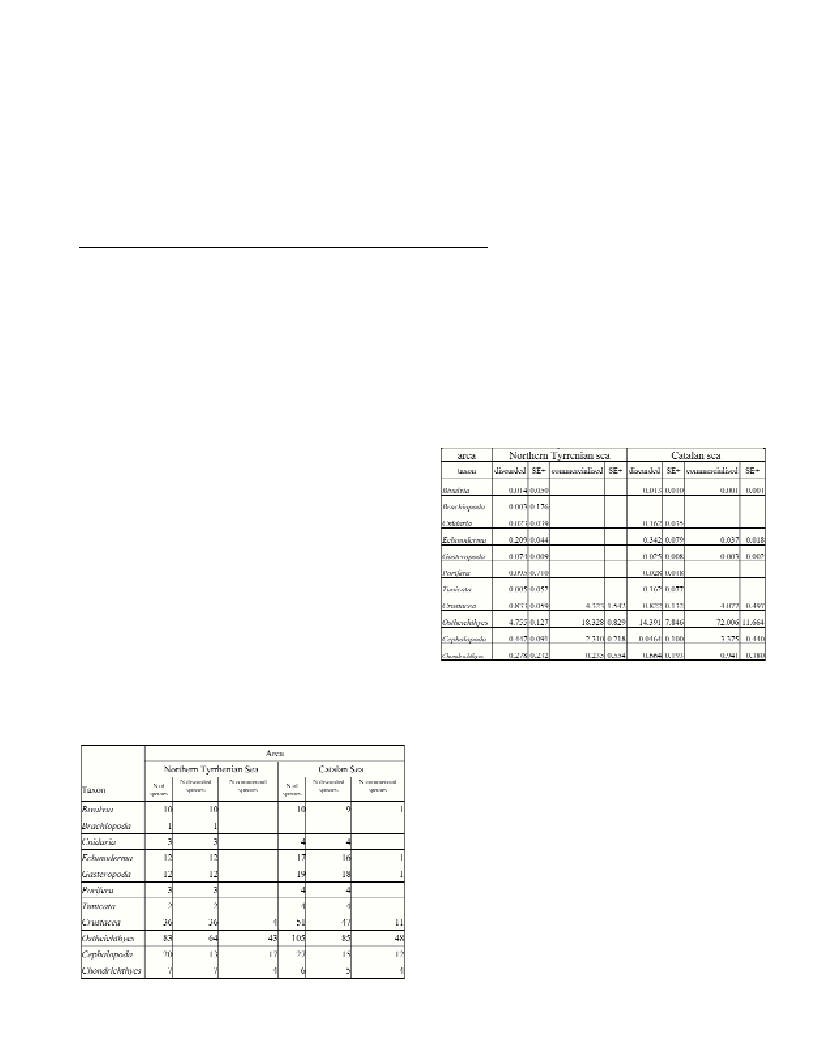DISCARD COMPOSITION OF THE EUROPEAN HAKE MERLUCCIUS MERLUCCIUS (LINNAEUS, 1758)
BOTTOM TRAWL FISHERY IN TWO AREAS OF THE NW MEDITERRANEAN SEA,
NORTHERN TYRRHENIAN SEA AND CATALAN SEA
P. Belcari
1
*, C. Viva
1
and P. Martín
2
1
Dipartimento Scienze dell’Uomo e dell’Ambiente, Università di, Pisa, Italy - * belcari@discat.unipi.it
2
ICM-CSIC. Barcelona, Spain
Abstract
This study provides data on the discard composition of the European hake bottom trawl fishery in two different areas of the NW
Mediterranean, paying special attention to the non-charismatic species. On board sampling was conducted monthly from February to July
2001. The total number of species caught was 189 (163 discarded, 68 commercial) in the northern Tyrrhenian Sea and 246 (207 discarded,
78 commercial) in the Catalan Sea.
Keywords: discards, Merluccius merluccius, bottom trawling, Mediterranean Sea
Rapp. Comm. int. Mer Médit., 37,2004
310
Introduction
Historically, fisheries management has been based on the results of
single-species stock assessment, without considering the ecology of
the species under management (e.g., habitat requirements, predation,
competition, discards, by-catch). Only in recent years the
environmental impacts of fishing have received increasing attention.
The reduction of discards and incidental by-catch is a priority in the
Common Fishery Policy of the European Union (1).Available studies
on discards in NW Mediterranean generally address the most
important commercial species (2, 3). The present study provides data
on the discard composition associated with the European hake trawl
fishery in two areas of the NW Mediterranean sea, with a special
attention to the less charismatic species.
Material and methods
The study was conducted in the northern Tyrrhenian and Catalan
seas (4). Sampling was carried out from February 2001 to July 2001.
A total of 60 commercial hauls was carried out on hake fishery
grounds (80-350 m depth). Scientific observers performed fishing
trips on board commercial trawlers every month, for three consecutive
days. The fishing zones were decided daily by fishers. Total catch was
analysed, the taxonomic composition was determined to species level
and the commercial and discarded fractions were recorded and
weighted.
Results and discussion
During the study period, 189 species were caught in the northern
Tyrrhenian Sea and 246 along the Catalan coast, indicating the
multispecies nature of the bottom trawling fishing activity (Table 1).
The commercial fraction was composed of 68 and 78 species in each
area, while discards consisted of 163 and 207 species, respectively.
Note that the same species could be discarded or commercialised.
Discarding depends mostly on the absence of commercial value of the
species and/or the occurrence of damaged or undersized (not
commercial) specimens. For some species, a minimum landing size is
in force.
Table 1. List of taxonomic groups caught in hake trawl fishery from the
two studied areas. Same species could be discarded or commercialised.
In both areas, the commercial part was composed of species
belonging mainly to four taxonomic groups (Table 2). Off the Catalan
coast, Stichopus regalisenjoyed high prices at the auction, despite its
low landings. The presence of Bolinus blandaris, a target species of a
particular artisanal fishery, and Pecten jacobeuscan be considered
accidental in the trawl catches. A marked dominance of Osteichthyes
both in terms of number of species (63% in the northern Tyrrhenian,
62% in the Catalan Sea) and biomass (72.3 and 89% respectively) was
observed. It was the highest catch of blue whiting in the Catalan coast
that determined the differences in the hourly yields within this group
in the two study areas.
Tab. 2. Mean abundance (kh/h) and standard error (SE) of the taxonomic
groups associated to hake fishery for the two studied areas.
With respect to discards, Osteichthyesdominated in terms of
number of species and by weight (39.0 and 70.4% of the total
discards, respectively, in the northern Tyrrhenian Sea; 41 and 84%, in
the Catalan Sea). The most abundant species always discarded in the
northern Tyrrhenian sea were the invertebrates Macropipus
tuberculatus, Plesionika heterocarpus, Octopus salutii,Astropecten
irregularis pentacanthus, Cassidaria echinofora, Alcyonum palmatum
and the fishes Gadiculus argenteus argenteus, Capros aperand
Scyliorhinus canicula. Most of the species discarded were similar to
those from the Catalan Sea, where, apart from the large number of
benthic invertebrates discarded, the highest discards were those of
blue whiting.
References
1-COM (2002) 656. Commission of the European Communities.
Communication from the Commission to the Council and the European
Parliament on the Community Action Plan to reduce discards of fish.
2-Carbonell A., Martin P., De Ranieri S. and WEDIS team, 1998.
Discards of the western Mediterranean Trawl ?eets. Rapp. Comm. Int. Mer
Médit.,35: 392-393.
3-Sartor P., Biagi F., Mori M., and SbranaM.,1999. Analisi dello scarto
di importanti specie ittiche nella pesca a strascico del mar Tirreno
Settentrionale. Biol. Mar. Medit., 6(1): 605-608.
4-Martin P., Carbonell A., Belcari P., 2001. Estimation of trawl discards
in the Western Mediterannean Sea. European hake (Merluccius
merluccius) as case study. Final Report, DG Fisheries Study 00/009.

